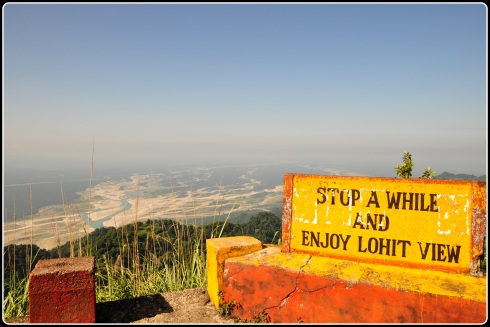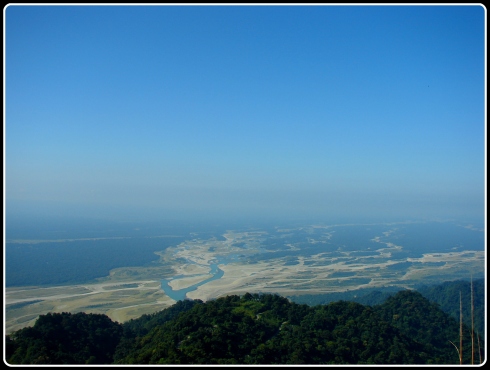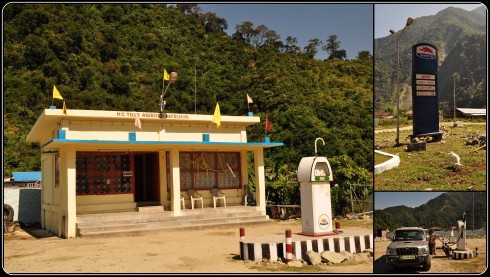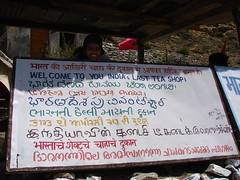
It all began with our Uncle. Uncle Moosa we call him. Not just us. Most of East Arunachal calls him that – and for good measure.

Uncle Moosa a.k.a Sathyanarayanan Mundayoor
It is Uncle, as part of a select band of social missionaries, who took a good part of two generations of the region on that delightful journey from A to B (and beyond!) And we are not even talking distances here. Which is what, usually, you would worry about when you think of a trip to Arunachal Pradesh.
Uncle quit a plush job in one of the most coveted of organizations – the Income Tax. While many were eager to land a job as an I.T.O., he quit it. That was not where his place was, he felt. Even as he did an M.A. in linguistics and bided his time there, bigger plans and a dream was preparing him for what he knew was his true calling.
One day he got the call. There was no caller ID those days. But he made out that it was from his inner self. He picked that, and a couple of bags, up and set out for that frontier where he saw the sun of his dreams rise. The destination was Arunachal Pradesh and the work cut out. Those were the early days of Vivekananda Kendra’s forays into lettering the North East and Uncle wanted to be a part of that movement. He, with a committed brethren of teachers and social activists, spent over 3 decades in the region – setting up schools, teaching and sculpting a future for generations.

32 years and thousands of students later, Sathyanarayanan Mundayoor a.k.a Unni a.k.a Uncle Moosa a.k.a Uncle Sir is pretty much an establishment himself. Only, now he has shed the Kendra’s banner and has donned another which hangs cheerfully outside his modest but neat library-cum-residence in Wakro, in Lohit district in eastern Arunachal– one of the thirteen small but purposeful reading rooms that he set up, almost single-handedly, in the remotest villages of the Lohit and Anjaw districts.

Uncle Moosa’s Calling Cards
Uncle has a simple yet meaningful enough explanation of his move from the Kendra to starting the library movement in the state. This was, he said, a change from a big umbrella to a smaller umbrella. He felt his role in his earlier avatar had ended and that he just had to begin something new. To do that, he felt it was time for the smaller umbrella to unfold.
Lest he should tick us off for attributing the success of the library movement only to him, a quick clarification. It would also not have been possible but for the contributions – much needed funds, encouragement and physical volunteering – by his countless well-wishers all over Arunachal and the rest of India, and well the world. If one’s deeds were to be the measure of one’s stature, Uncle Moosa towers above most everyone we have met!

And it was Wakro, his present base, that we were eventually headed towards. There were still a few more places to be covered before that – Tezu, the many small villages along the Lohit; Walong and further up all the way to the Chinese border. These were more than lovely, lesser known places (which is what travellers like us seek them out for). For someone like Uncle, these were the outposts that needed all the support required to spread the light of learning and knowledge – places that his library movement had been blessed by. Each of these libraries had been set up by him (and, directly or indirectly, by his small but committed band of well-wishers, patrons and volunteers) in all those long, relentless trips made to these remote parts, carrying books and other material mostly by himself.
For anyone who thinks a trip to East Arunachal is easy, it is not. Unlike Tawang or Itanagar, this part of the state actually is not on travel agent itineraries. There aren’t even many options to stay…and certainly no hotels or resorts – something that, thankfully, we were not affected by. For, we had already got to sample some of the amazing social fare that Uncle has been instrumental in whipping up in East Arunachal. Our innerline permits, the logistics of our transportation, the social support we had en route to Pangsau…these otherwise formidable hurdles were, as if, never there. We are not sure how much Uncle realizes it, but for even someone as unstoppable and irrepressible as him, his reputation continues to precede him. And we were certainly not complaining! The warmth and affection with which we were received everywhere were ample proof of that – and we were more than happy to be the unwitting beneficiaries of that largesse.
We were back on the road again. Our “stroll down the Stilwell memory lane” and “the walk in the woods” in remote Namdapha brought us out via Bordumsa to the Mahadevpura border of Arunachal Pradesh, thanks to Jayanto da and his trusted Scorpio. A brief stop for lunch at a cross between a restaurant and a dhaba in Bordumsa was fulfilling.

Lunch at Bordumsa
Crossing the new bridge on the Lohit and passing the newer still the Golden Pagoda at Tengapani, we reached Chongkham. From the bridge, the monastery complex glistened in the evening sun.

Chongkham Buddha Vihara
At the crossroads, one road led to Wakro and Parasuramkund, the other towards the Pagla Ghat. As we were headed to meet Uncle in Tezu, we took the latter, enthused by the idea of the ferry crossing, with us and our vehicle in tow.

Ghat crossing across the Pagla Nadi
As with all ghat crossings, patience and luck are just as important as the ferry and the boatman! We were a little short of the former but were still blessed with some good fortune. A cool wind blew over the feisty Pagla Nadi (the mad river – named aptly so) and there weren’t too many people waiting to get across.

While waiting to get across
But it was a rare sight of the sun and the moon in the sky above that we were treated with. If the sunset on our left was blazing, the moon up above was a cool white.

Sun goes down…
The short cruise over the Pagla river was the stuff that indelible travel memories are made of. The sun was down but only just to cast a dull golden filigree over the wavy waters. Very few of us talked. Fewer still clicked pictures. That was not entirely surprising, given that this part of the state were, mercifully, not run over by tourists – yet.

…and the moon goes up
Over at the other bank, we drove through pitch darkness across the sandy terrain for a few kilometers till we joined the road that came from Sunpura and headed for Tezu. An hour into the ride, the first signs of the headquarters of the Lohit district could be seen in the failing light.

Tezu town, headquarters of Lohit district
It’s not hard to like Tezu. It looked like one of those quiet cantonment towns, leafy and wooded. With the sun all but down, the shutters also fell in the shops on the main street. We were to meet Uncle at the library and spend the evening amidst books and children. But the ride from Miao and the ghat crossing had taken longer than we had thought. So we decided to meet him at the Circuit House and catch up on the library visit early next morning.

Circuit House, Tezu
The Circuit House itself was an expansive affair, located as it was on a large plot by the roadside. Almost colonial in its build, the rooms are spacious if basic. Anyway, there aren’t very many accommodation options in Tezu, otherwise. That kind of puts things in perspective and makes you want to be contented with what there is. By the way, it’s not easy to get a room in these, otherwise, government accommodations. And we had Uncle to thank for this.
He met us shortly after. It had taken us a long time to answer his invite. Every letter, mail, phone call, face to face chat would inevitably end with his asking us to come over and visit his beloved Arunachal. Over the years, the priority of this journey had got beaten up, and down, by many other commitments that come in the guise of practicality and everyday compulsion. But as so often happens in fiction – but rarely in real life – the good finally prevailed and our Arunachal trip materialized.

In and around the Circuit House
In the warm confines of our room, we sat talking, catching up on his work and filling him in with our eventful first three days of our trip. We were soon joined by his dear friends and well-wishers – Moyum an erstwhile student of Uncle and now working in the Land Management Department of the DC’s office in Tezu; Bapen another ex-student and herself well settled as an Urban Planning Officer (UPO) of Anjaw district; and, last but not the least, the smiling and unassuming Etalo, volunteer library activist and in charge of Bamboosa Library from its inception. We basked in the collateral regard and affection that these special friends of Uncle’s extended us and we opened up to them with the ease that you could only do, instantly, to Arunachalis.
We were in for yet another pleasant surprise. Just when we were feeling the effects of our lunch at Bordumsa waning, Uncle told us of what lay ahead for the evening. Hearing of our visit from Moyum, her friend and colleague, Basila didi had graciously offered to host us all for an authentic Mishmi dinner. It seemed that no time was being wasted in our being able to sample the flavour of our new destination – and we were grateful to Moyum and our host for the evening.
Basila didi lives in her Mishmi home in Tezu with her two children. Along with Moyum, she too works at the Land Management Department of the DC’s office in Tezu and is a well-wisher and a voluntary activist of the Bamboosa library. We walked into a house that was beautiful not just on account of the festivities of the Pooja season but also by virtue of Didi and her two adorable children.

from L to R clockwise – Dhekiya fern; Pooja offerings; Pooja decorations; Bhoot Jhalokia
For us, to say the very least, it was all utterly overwhelming. The day had begun with a farewell to Namdapha, a goodbye to the lovely Phupla Singpho family, a hearty ethnic lunch in Bordumsa, a memorable ghat crossing, a touching reunion with Uncle in his own special backyard…and now this. Being invited home by someone who we had never spoken to till then and being served authentic, delicious local cuisine in a chang-ghar…life doesn’t bless you with many of such days.
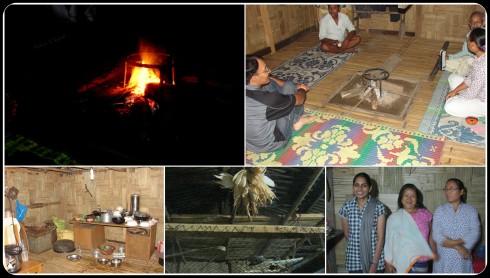
At Basila didi’s home; huddling around the Chang-ghar
A word on the setting of the dinner and the food itself. The chang-ghar is, in these parts, an elaborate wooden structure built on stilts. Inside, the kitchen occupied one part of the room while in the middle was a hearth with a warm fire. We huddled around that and had what was, probably, one of the most memorable meals of our lives. A lal chai (black tea) and some small talk later, Basila didi’s main course arrived. Delectable dhekiya (fern) sabzi with a dal were suitable accompaniments for white sticky rice. But it was a tentative bite of the infamously hot Bhut Jhalokia pickle that set our mouths on fire, almost blowing the roofs of our palates sky high. We could barely murmur our profound appreciation and thanks for the meal and the exquisite gale (the local colourful skirt) that Didi presented. It was too much of an occasion not to be consigned to posterity.
The next day was when we would set off early morning for a long and exciting drive all the way to Walong. When that kind of a day is preceded by one as eventful as this, it’s a long night that separates the two. But we were tired…and tired we didn’t want to be tomorrow. Back at the Circuit House, it didn’t take long for the lights to be put out for the day.
A word also on our miss of the day. Dawns break early in that part of the country. We were earlier still. We wanted to drive in to Walong and see it while it was still light.

Bamboosa Youth Library, Tezu
But before our long journey east, there was one important thing left to be done.
The Bamboosa Library. We were eager to put a form to what we had heard Uncle tell us about it all these years! Established on May 19, 2007, this was the first endeavour as part of the AWIC – VT Youth Library Network. Run by the Vivekananda Trust, headquartered in Mysore, there are now 13 of these mini libraries spread across the Lohit and Anjaw districts…most of them in the far flung villages higher up in the hills. There is more beyond the books stacked neatly in the shelves. There are frequent book exhibitions, reading sessions, workshops on improving reading skills, cultural and sports programmes, environmental awareness and much more.

Bamboosa Library, Tezu; Clippings, letters and mementos
The library itself is housed alongside a computer training school. Decked up with drawings and sketches and poems and photos and newspaper clippings, it is the true altar of the written word. Etalo, the resident head priest of this temple of books, joined us there soon after. There was already one keen young book lover and keeper of the keys, Purbi, already there. We spent a good part of an hour there lost among books, chatting up with the intent library volunteers and Uncle himself.
We wanted to stay back a little more but were happy that we could, at last, get here and see for ourselves the ground Uncle and his movement had covered. For someone who deeply believes in children and wants to get them to fall in love with books, the ultimate payoff would be for the young minds to recognise books as their soul-mates. That, for Uncle Moosa, is job done!

With the library activists at Bamboosa Library, Tezu; Moyum, Uncle Moosa, Etalo and Purbi
It was a long day ahead and, shortly, we were on the road again. As we passed the road that wound up to the serene Tafragam village, we remembered Uncle telling us of the even more serene VKV girls school up above. That would have to wait for a later visit to Tezu.
For now, we were headed for Walong. Names that we had till then only seen on the map or heard from Uncle were now on the road ahead. Hayuliang, Hawai, Walong, Kibithu, Kaho…the places would change, but there was one constant that would be a part of our 200 km drive up. And that was the Lohit – the river both beautiful and tempestuous, gushing down all the way from China and flowing into the Brahmaputra.
And then, in less than a week, we would be in Wakro! We would be with Uncle again and this time sharing his space with him – spending time with him at the Apne library, with his books, with his little patrons from Apna Vidya Bhavan and Kasturba Gandhi Balika Vidyalaya, with the wonderful staff of these fine schools and, never the least, the two remarkable people who started and run these excellent institutions. But that will be quite another story and we will tell it once we reach Wakro.
For now, we were glad we were, finally, in Arunachal and with our dear Uncle Moosa!


















































